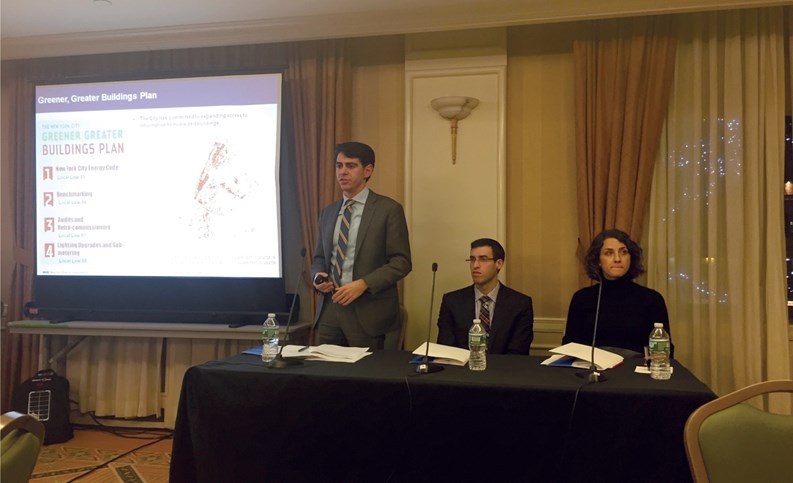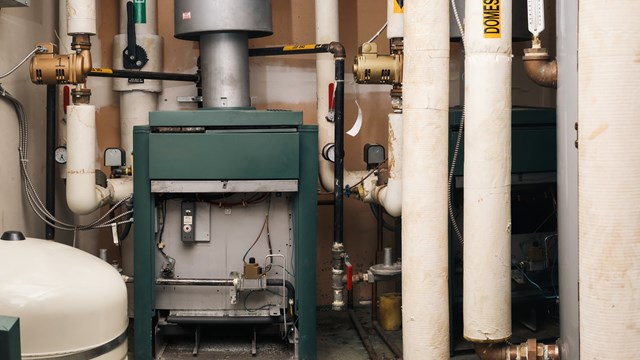New York City buildings have achieved 100 percent compliance with Local Law 43, a part of the overall Greener, Greater Buildings Plan put in place in 2009 to improve the energy efficiency of existing buildings and reduce the city’s carbon footprint over time. LL43 requires that buildings phase out No. 6 heating oil in favor of cleaner grades of fuel or natural gas.
On August 16, 2010, former Mayor Michael R. Bloomberg signed Local Law 43, which requires that all buildings in New York City convert to cleaner grades of heating oil, either No. 4 or No. 2, and eventually phase out their use to natural gas. By 2015, all existing boilers that are currently burning No. 6 oil were required to convert to cleaner fuels like No. 4 oil temporarily (or directly to No. 2 oil or natural gas, or both).
By 2030, all properties are scheduled to convert to No. 2 oil or natural gas, or a combination of both, known as “dual fuel.”
Local Law 43 also mandates sulfur content in heating oil No. 4 had to be reduced in half from 3,000 ppm (parts per million) to 1,500 ppm. Additionally, all heating oil today must contain 2 percent biofuel.
Reduce Greenhouse Gases
One of the main components of the city’s plan, according to Patrick Love, who spoke at Argo Real Estate’s Argo University for Boards on February 25 at the Hotel Beacon, was that New York City is aiming for a 40 percent reduction in greenhouse gases by 2030 and an 80 percent reduction by 2050.
Love, the New York City Carbon Challenge coordinator in the Mayor’s Office of Sustainability under Mayor Bill de Blasio, noted that one of the main contributors to pollution happens to be buildings. “I sit within the Mayor’s Office of Sustainability, and what our office is tasked with doing is improving the environmental quality of New York City through a series of programs and policies that we have,” he says, adding that teams are working on environmental remediation, greenhouse gas reduction, building energy efficiency, waste initiatives, and transportation, among other programs.
“What we’re tasked with doing is creating this suite of programs and policies that add up together to be New York City’s comprehensive greenhouse gas reduction strategy, comprehensive sustainability strategy. So under the de Blasio administration we have this overarching sustainability plan called One New York. You previously might have known this as PlaNYC, same document, now updated under the new administration, a little bit more expansive in its scope and reach.”
Targeting Buildings
“In New York City, the majority of our greenhouse gas emissions come from our building stock. So around 70 percent of greenhouse gas emissions come from the electricity that comes to light our buildings, the heating and cooling in our buildings, and also there’s other pieces of this pie that add up to our greenhouse gas profile. But in New York City our largest share is buildings,” says Love.
Love also touted the success of the NYC Clean Heat program. According to a press release, as of June 30, 2015, No. 6 heating oil has been phased out as a primary heating oil in New York City buildings. The New York City Department of Environmental Protection had achieved 99.8 percent compliance at program’s end.
“Between the beginning of NYC Clean Heat in 2012 and the program’s end in 2015, nearly 6,000 heating oil conversions were completed from No. 6 or No. 4 oil to a cleaner fuel. More than 75 percent of these conversions have been to one of the cleanest fuels, which include ultra-low sulfur No. 2 oil, natural gas, biodiesel, and steam. Roughly 1,500 buildings converted to a cleaner fuel just in the past year, many with the help of NYC Clean Heat,” according to officials.
Comprehensive Savings for Boards
Joshua Soble, an account manager with Bright Power, an energy management firm, said that his company has been working with city planners and buildings to implement all phases of the city’s energy efficiency plans.
Soble presented a few case examples of how eliminating No. 6 oil and implementing other energy and water conservation measures resulted in comprehensive savings. Chelsea Gardens, for example, a six-story, 151-unit complex in Manhattan, converted and decommissioned its No. 6 boiler, upgraded heating controls, balanced its steam distribution system, and installed new boilers and mixing valves, to the tune of a total project cost of $732,312. Lighting and water measures were also installed and the building received $105,700 in NYSERDA incentives. The projected first year energy savings is $192,055 and the projected payback is about 3.3 years. Energy usage was reduced by about 16 percent.
A second building—a 17-story, 139-unit co-op in the Bronx, turned out to be even more efficient. Its HVAC system was converted to natural gas, new boiler pumps, motors, valves, and Heat Timer controls were installed, along with a 75kW co-generation system. Lighting, air filtration, Energy Star appliances and new water aerators and plumbing fixtures were also put in. This $1.43 million project will achieve a 32 percent energy reduction. The first year energy savings is estimated at $307,233 with projected payback of 4.7 years. The building was eligible for a $139,000 NYSERDA incentive.
Local Law 87 is somewhat more involved than Local Law 84, which is the introductory benchmarking, Soble says, so it’s only required to be completed every 10 years rather than annually. “It’s not just a data collection and analysis exercise. Local Law 87 involves an engineer going on-site, completing extensive surveys of all the building’s mechanicals, all heating and cooling systems, and then ultimately, working with the board, so that a report that results from Local Law 87 is of use to the building.”
There are two halves to Local Law 87, says Soble, the retrocommissioning half and the energy audit half.
“Retrocommissioning is essentially just the tuning and optimization of all of the existing systems in the building. If your building has a boiler, that’s an existing system in the building. If you don’t have a chiller system, you obviously don’t have to tune any central cooling systems in the building. These are some of the more common corrections that need to be made as part of the retrocommissioning process in order to tune and optimize those systems in the building. I think the two most common that we see are pipe insulation and weather-stripping,” says Soble.
“Sometimes making these corrections in your building can feel somewhat punitive but it’s actually not. The really great thing about the retrocommissioning portion of Local Law 87 is that when you make these corrections you’re improving the existing systems in your building so you’re going to start seeing immediate returns on the work that you’re completing. This isn’t something that you’ll see down the line—this is improving the existing conditions in the building today.”
The energy audit comes with a list of recommendations the building can pursue in order to become more energy-efficient. Soble said that these are generally larger-scale projects that might involve installing new systems; making significant changes to existing systems in the building. If your boiler is old and not operating as efficiently as it used to or it shuts down frequently, that might be a recommendation. Another common initiative is installing LEDs in your building or installing sensors. Or perhaps on-site power generation or solar panel systems might be recommended, he says.
He cited one 86,000-square-foot building in Brooklyn, which just did the retro-commissioning but did not complete any of the building recommendations. The building wanted to take their time and investigate the best energy savings options, he said. The project cost was roughly $30,000 and the result was a cost per unit of about $385 or a savings of about 6%. Comfort in the building was improved by replacing gauges and sensors that weren’t operating properly.
Soble noted that if your building seeks to convert to natural gas Con Edison has what’s called an Area Growth Zone program in which it has mapped out areas where the natural gas pipelines are available. A building needs to enroll in the program and get on a short list if your property is in one of these growth zones, he says. “This program can actually bring natural gas to your building on a set schedule.”
Phil Madnick, the manager of Con Edison’s Multifamily Energy Efficiency Program, provided an overview of what Con Ed offers and detailed the application process that boards and management need to go through to enroll in the program.
Common measures, Madnick explained, on the electricity side, include chillers, variable frequency drive pumps and motors, and building management systems. For this, savings ranges to about $.25 per kWh saved. On the gas side, replacing burners, installing building management systems, master venting and steam traps, could save $2 per therm.
He likened the energy savings to a windfall that’s hard to match. “That’s buried treasure within your own building,” he says.
The process begins with filling out a multifamily performance program application, getting assigned to an account manager, determining what type of project the install will be, and selecting a contractor to do a complete energy overhaul or prescriptive measures such as lighting upgrades, insulation or boiler or HVAC improvements.
High Performance Program Available
Laura Humphrey, senior project manager for the New York State Energy Research & Development Authority (NYSERDA), said the state is committed to a $5 billion investment in energy programs to make New York State one of the leaders in energy efficiency and sustainability.
Humphrey talked about the specific rebate programs offered by NYSERDA and said that they work with a number of providers including Bright Power. There are basically three options: Targeted Option; Comprehensive Option; and the High-Performance Option. The targeted option is for single or multiple improvements, such as replacing an air source heat pump, a hot water or steam boiler, a water heater, Energy Star appliances, a fan, or variable speed motor drives. The comprehensive option is a whole building approach that bases a per-unit incentive to reduce the building’s energy usage by at least 25%. The high-performance program, which is new, aims to provide deep savings up to as much as or more than 40% for eligible buildings.
“To date, New York City has reduced its emissions by 19 percent from 2005 to 2013,” Love told the Argo board members at the event. The result of this reduction is more breathable, cleaner air for city residents, he says.
As of 2011, while only one percent of New York City buildings used No. 4 or No. 6 oils to heat their buildings, studies showed that they accounted for more soot pollution than all of the cars and trucks in New York City combined.
Debra A. Estock is managing editor of The Cooperator.







Leave a Comment